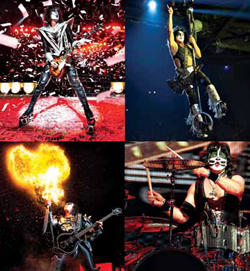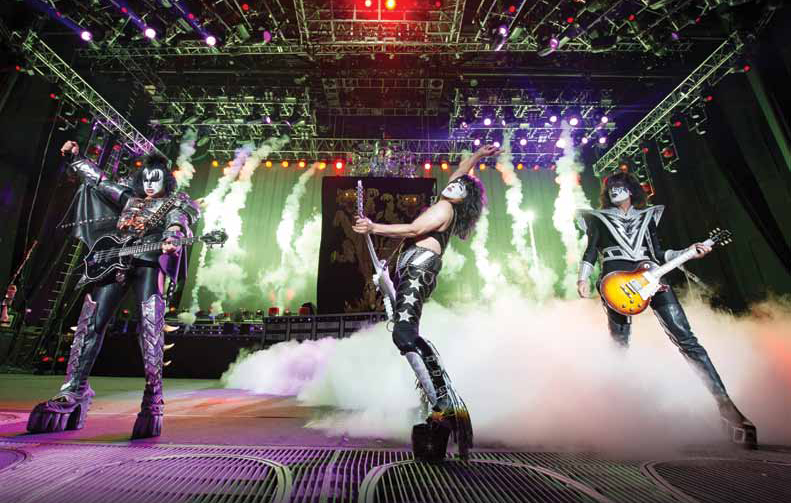
Symmetry Or Not
The tour’s lighting was designed jointly by KISS production manager Patrick Whitley and Mötley Crüe production manager Robert Long, with drawings executed by Sooner Routhier.
With two distinctly different trims of the trusses, the shows took on two totally different looks, one being a big symmetrical monster (KISS), and the other an asymmetrical exercise in mayhem (Mötley Crüe).
Sean “Motley” Hackett served as lighting director for KISS, while Michael Cooper occupied the same post for the Crüe.
“On this tour you got what you needed, not necessarily what you wanted,” Hackett says. “Many times it got to be quite a crazy situation with so much stuff crammed into our working space and limited time to get our shows ready.
“If either Michael or I were demanding prima donnas, it would have created a lot of unnecessary tension. Fortunately, I can’t stress enough how well we both worked together, giving each other both space and time when it was needed.”
Both Hackett and Cooper programmed the basic foundations of their shows. Lighting and video programming for Mötley Crüe was done through an MA Lighting grandMA2 series console and Cooper’s Catalyst media server.

Some songs—mainly those incorporating a lot of video—were synched with time code to help tighten things up within an overall framework incorporating well over 800 cues.
“Other than using the exact same fixtures and crew, I don’t know if the shows could have had any more contrast,” Cooper notes. “KISS was big, bright, used lots of IMAG, big gags, there was definitely an everything all the time kind of mentality at work there, and Sean did a great job with it.
“Conversely, Mötley Crüe’s show was edgy, with really low-trimmed trusses, aggressive video and lighting looks, lasers, and lots of fog. I’d say whoever came out to see this show got every penny’s worth out of their ticket, especially if they were fans of both bands. No one compromised, we all worked together to get as much out of each show as possible every night, even in the most challenging venues.”
Both Cooper and Hackett utilized grandMA2 consoles, although the latter came to The Tour having always used a grandMA series 1 work surface.
To bring himself up to speed quickly on the grandMA2, Hackett traveled to ACT Lighting in Los Angeles, where he received a crash course on the console’s workings and received help converting his MA1 show foundation to an MA2 file.

Being Seen
Beyond a few movement and intensity effects, the process of bringing the KISS lighting show to life is largely a hands-on affair.
“Most of it is all manual bump-and-grind like the pre-digital consoles I grew up on,” Hackett reveals. “KISS is all about being symmetrical, with big monochromatic color looks. Much of what I do is about the band being seen, so the spots are bright. I can go from one simple spot to 200 moving lights in your face.”
For the KISS show, the main lighting workhorses used to produce the big banks of color the band likes are VARI-LITE VL3500 Wash luminaires numbering 113 in total. Slicing through the lumens generated by these fixtures with added beams were 78 Sharpies, as well as NC mole lights and Atomic strobes.
